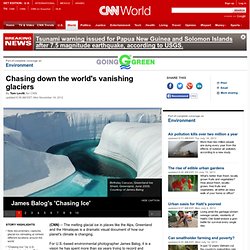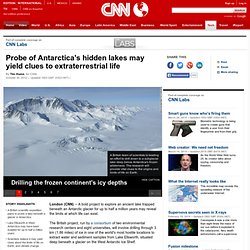

life is just like a sea with,full of waves.So you got to except the up's and down's dont let it drown,you can stay afloat.What i'm trying to say is even if things get rough,don't loose hope. LOVE TO MEET NEW PEOPLE,GO OUT,AND MOST OF ALL GO SHOPPING!!!!!!!!!!
Deep ice cores show past Greenland warm period may be ‘road map’ for continued warming of planet. A new study by an international team of scientists analyzing ice cores from the Greenland ice sheet going back in time more than 100,000 years indicates the last interglacial period may be a good analog for where the planet is headed in terms of increasing greenhouse gases and rising temperatures.

The new results from the NEEM deep ice core drilling project led by the University of Copenhagen and involving the University of Colorado Boulder show that between 130,000 and 115,000 years ago during the Eemian interglacial period, the climate in north Greenland rose to about 14 degrees Fahrenheit warmer than today. Despite the strong warming signal during the Eemian -- a period when the seas were roughly 15 to 25 feet higher than today -- the surface of the north Greenland ice sheet near the NEEM facility was only a few hundred yards lower than it is today, an indication to scientists it contributed less than half of the total sea rise at the time.
Study Sheds New Light on Arctic Sea Ice Volume Losses. Dear Mr. President: Why on Earth Are You Letting Shell Drill in the Arctic? The Obama administration has authorized Royal Dutch Shell to begin preparatory drilling in the icy, vulnerable waters of the Chukchi Sea, 70 miles northwest of Alaska in the Arctic Ocean.

On Thursday of last week, the Federal Bureau of Ocean Management issued a permit that will allow Shell to drill holes at certain depths in the ocean floor, even though the company’s oil spill containment barge has not yet been completed. On Friday, the Environmental Protection Agency made things even easier for Shell, granting a one-year air pollution permit that will enable the generators on Shell’s offshore drill ship to emit nitrous dioxide and ammonia at levels that are currently above federal safety limits. MORE: Polar Bears Beware! Shell Oil Is Coming to Town U.S. While final permits have not yet been issued, last week’s events represent a huge step forward for Shell, which has fought for seven years to begin drilling in the Arctic, and has spent $4.5 billion on the effort. Chasing down the world's vanishing glaciers.
Birthday Canyon, Greenland Ice Sheet, Greenland, June 2009.

Courtesy of James Balog EIS time lapse cameras at Columbia Glacier, Alaska, Aug 2009. "I never really expected to see this magnitude of change. Every time we open the backs of these cameras it's like 'wow, is that what's just happened,'" Balog said. Courtesy of James Balog Aerial view of meltwater on Greenland Ice Sheet, June 2010. Aerial view of pancake ice, Ilulissat Isfjord, Greenland, March 2008. "Ice diamond," Jökulsárlón, Iceland, Feb 2008.
Greenland Ice Sheet, Greenland, July 2008, Silt and soot blown from afar turn into black "cryoconite," absorb solar heat and melt down into ice. Close up of an iceberg, Mendenhall Glacier, Alaska, Sept 2010. Probe of Antarctica's hidden lakes may yield clues to extraterrestrial life. A British team of scientists is leading an effort to drill down to a subglacial lake deep below Antarctica's frozen wilderness.

The research will provide vital clues to the origins and limits of life on Earth. The British camp near Lake Ellsworth -- one of about 400 subglacial lakes in Antarctica. The team plan to use a specially-designed hot water drill to blast through the ice to the untouched waters 3 km (1.86 miles) below. The lake, which is about 10 km (6.2 miles) long and 2-3 km (1.24-1.86 miles) wide, lies about 3 km beneath the ice. Scientists believe it will contain contain life, potentially including bacteria and viruses unknown to science, but say it will be even more scientifically significant if no life is found in its waters.
The drilling site above Lake Ellsworth, with the Ellsworth mountain range in the distance. The drill, shown here during testing, will blast through the ice using the heat and pressure of water at 90 degrees Celsius. All About Romance.
Pearltrees tips.